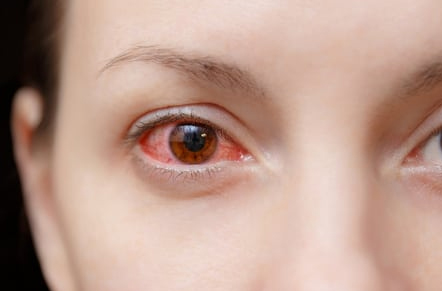

“IRITIS – INFLAMMATION OF IRIS”
Iritis is swelling and irritation (inflammation) in the colored ring around your eye's pupil (iris). It is also called as anterior uveitis.
The uvea is the middle layer of the eye between the retina and the white part of the eye. The iris is located in the front portion (anterior) of the uvea.
Iritis is the most common type of uveitis. Uveitis is inflammation of part of or all of the uvea.
SYMPTOMS
CAUSES
Often, the cause of iritis can't be determined. In some cases, iritis can be linked to eye trauma, genetic factors or certain diseases. Causes of iritis include:
Injury to the eye. Blunt force trauma, a penetrating injury, or a burn from a chemical or fire can cause acute iritis.
Infections. Viral infections on your face, such as cold sores and shingles caused by herpes viruses, can cause iritis.
Genetic predisposition. People who develop certain autoimmune diseases because of a gene alteration that affects their immune systems might also develop acute iritis. Diseases include a type of arthritis called ankylosing spondylitis, reactive arthritis, inflammatory bowel disease and psoriatic arthritis.
Behcet's disease. An uncommon cause of acute iritis in Western countries, this condition is also characterized by joint problems, mouth sores and genital sores.
Juvenile rheumatoid arthritis. Chronic iritis can develop in children with this condition.
Sarcoidosis. This autoimmune disease involves the growth of collections of inflammatory cells in areas of your body, including your eyes.
HOMOEOPATHIC MANAGEMENT:
Aconite : In very first stage and in sudden reappearance especially in young, plethoric people from exposure to a cold draught of air. TRAUMATIC IRITIS; ciliary injection marked, pupils contracted, severe beating and throbbing pains (<) at night; sensation of great heat, burning and dryness in eyes; general febrile excitement.
Arnica : Traumatic and rheumatic iritis.
Arsenicum : Serous iritis, with periodic burning pains, worse at night, after midnight, better by warm applications.
Asafoetida : More applicable to females; syphilitic iritis, or after abuse of mercury; pains severe in eye, ABOVE IT, in temples of a throbbing; pulsating, pressing, burning or sticking character and tend to become periodic; soreness of the pressure (reverse of Aurum); worse at night.
Aurum : Syphilitic iritis, and after overdosing with mercury or potash; PAIN DEEP IN THE BONES surrounding the eye; tearing pressing, often extending into the eyeballs, with burning heat, especially when opening eyes; pain from ABOVE DOWNWARD and from WITHOUT INWARD, aggravated on touch; vision clouded ad by dark veil; mental depression, bones-pains in other parts of body.
Belladonna : Early stages, caused from a cold, with much redness and throbbing pain in eye and head; congestion of conjunctiva, ciliary neuralgia, photophobia; sensitiveness of eyeball to touch; congested face.
Bryonia : Rheumatic iritis, with sharp shooting pains in eyes, extending through into the head and down into the face; soreness and aching in and around the ball, especially behind it, extending through to occiput; pain as if the year were forced out of the socket; aggravated by moving or exerting the eyes and at night.
Calendula : Traumatic iritis.
Cedron : Severe ciliary neuralgia during iritis, if supraorbital, with MARKED PERIODICITY, removing the nervous irritation.
Chamomilla : Iritis from loss of vital fluids or malaria;pains variable, but
Cimicifuga : Rheumatic iritis, with intraocular tension and much pain; ciliary neuralgia, aching pains in eyeballs or in temples extending to eyes; (<)at night, it seemed as if would get crazy; SHARP SHOOTING PAINS FROM OCCIPUT THROUGH TO EYES, or darting from eyes to top of head, with redness of eyes and photophobia, right side, afternoon and night, (>) on lying down.
Cinnabaris : Syphilitic iritis, CONDYLOMATA ON IRIS AND LIDS; pain commences on inner canthus, extends across brow or passes around eye and shooting pains through eye into head, especially at inner canthus. Sharp pain over eye, or soreness along course of supraorbital nerve or corresponding side of face, (<) at night and intermitting in severity.
Clematis : Chronic syphilitic iritis with very little pain; heat and dryness in eye and great sensitiveness to cold air; to light and bathing. (It is said to have marked action on the adhesions between iris and lens.)
Colchicum : Gouty or rheumatic iritis, with great soreness of eyeballs; violent, short, sharp, tearing pain in and around eyeball; excoriating lachrymation, (<) in open air.
Colocynthis : Iritis with severe, burning, sticking and cutting pains extending from eye up into head and around eye, or else aching pain going back into head, on rest night and on stooping, (>) by firm pressure and walking in a warm room, acrid and profuse lachrymation.
Conium: Descemetitis with excessive photophobia and but little redness or apparent inflammation; strumous ophthalmia of a sluggish nature.
Euphrasia : Rheumatic iritis, iris reacts tardily to light, being discolored and bound down by adhesions, and aqueous humor cloudy from the admixture of the products of inflammation; pain burning, shooting, stinging, (<) at night, attended with acrid lachrymation; photophobia; ciliary injection; coryza perfectly bland.
Gelsemium : Serous iritis alone of complicated with chloroidal exudations; hypersecretion, cloudiness of the aqueous, with moderate ciliary injections and pain.
Hamamelis : Iritis traumatica or other forms, in which haemorrhage took place into the iris or anterior chamber.